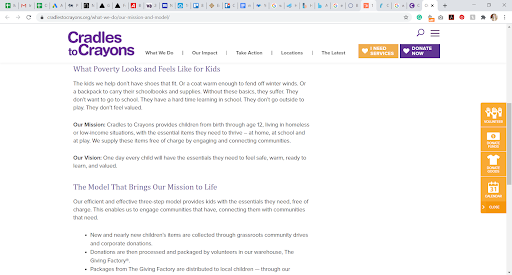Why does the business you run or work for exist? What does it want to achieve? It can be easy to forget this important information when you’re focused on day-to-day tasks and fulfilling company goals.
You might know the company’s mission by heart, but do your customers know what it is? How often do you think about it when it comes to how your business works and how you connect with customers?
If you want to stand out in the market, then you need to make sure everyone knows your mission, and that they can access it whenever they visit your website. That’s why you need to put together a company mission statement.
Overview: What is a mission statement?
A mission statement describes what a company does now, how it does it, who does it, and why. It’s the who, what, why, and how (and sometimes where) of the business world, and it informs your ideal customer profile.
Information that you might put in your mission statement includes your company’s values, backstory, and current goals. This information helps explain what you’re about to prospects and to build relationships with customers as they can understand if you’re the right fit for them.
Mission statement vs. vision statement: What’s the difference?
The terms “mission statement” and “vision statement” are often used interchangeably and for good reason. They are intrinsically linked and very similar. Some businesses combine both statements to summarize their current goals and overall vision.
In general, a mission statement describes what a business does now and how it does it. A vision statement is aspirational and focuses on the future.
Both statements include details on company goals, but a vision statement will often tend to have loftier and more vague goals, while a mission statement includes information about what the business is trying to accomplish currently.
How to write a mission statement for your small business
Here are our top three tips on how to write a mission statement for your small business and the information you need to include.
1. Explain what your business does
In your head, it’s probably crystal clear what your business does. But you have to get back to basics when you want to explain it to potential customers, suppliers, or partners.
If you’ve been working at a company for a while, you likely have picked up industry jargon and use words and terms specific to your organization. Remember that not everyone speaks like you. You should avoid these phrases and stick to plain English, no matter what industry you work for.
Don’t assume your customers already understand what you do or know your industry well. Have you ever read explanations of highly technical products written by the people who built or designed them? They’re often incomprehensible and assume you have the same level of knowledge as they do.
If people have to Google or research any words or concepts in your explanation of what you do, then you’re on the wrong track.
Take PayPal’s mission statement: “To build the web’s most convenient, secure, cost-effective payment solution.”
It’s simple but specific and easy to understand. It also perfectly defines what the company does.
Contrast that with its vision statement, which is an aspirational statement that reflects its work and values: “PayPal’s vision is that every person has the right to participate fully in the global economy, and that we have an obligation to empower people to exercise this right and improve financial health.”
2. Describe how your business operates
This step doesn’t require you to go into the nitty-gritty of your business model. Instead, this is where your core business values come in. If you haven’t already defined these values, now is the time to do it. Get your management team together and send out a survey to your employees to work out what these values are.
Core values might include:
• Customer-centric (see Amazon example below)
• Socially conscious (see Warby Parker example below)
• Efficient
• Dependable
• Affordable
• Honest
• Flexible
• Data-driven
• Transparent
• Consistent
Note that these values reflect how you operate and are publicly available to all potential customers and partners. They reflect how you run your business and how you treat and engage with customers. You might also have a set of values that describes how your employees are expected to operate.
3. Give the why behind your business
Think back to the reason you set up your business and what problem that you wanted to solve. This is the why behind the business — the reason your company was set up.
If you didn’t set up the business, then sit down with the founders and ask them to give you the lowdown on the unique problem that the company can solve. Tell your company’s story in a way that resonates with potential customers.
Take the example of Starbucks. We all know what they do, but do we know why they do it? That’s where the company’s mission statement comes in: “To inspire and nurture the human spirit — one person, one cup, and one neighborhood at a time.”
Nurturing the human spirit and connecting neighborhoods shows that Starbucks is more than just a coffee chain; they have a mission and one that draws customers in.
3 examples of inspiring mission statements
What makes an inspiring mission statement can be subjective, depending on what you are looking for in a business and what kind of values you identify with. But mission statements should be written in plain English and specifically describe what your company does.
Here are some good mission statement examples.
1. Warby Parker
“To offer designer eyewear at a revolutionary price, while leading the way for socially conscious businesses.”
Eyewear retailer Warby Parker knocks it out of the park when it comes to mission statements. Not only does it state very clearly what it does (offer eyewear), but it also specifies this is designer eyewear at a more affordable price.
The company doesn’t just stop there. It states its value proposition of being a socially conscious business so consumers know how it operates and what approach it takes to running the company.

2. Cradles to Crayons
“Provides children from birth through age 12, living in homeless or low-income situations, with the essential items they need to thrive — at home, at school and at play.”
Cradles to Crayons’ mission statement is a bit longer and wordier than some of the others, but that can be a necessary step, depending on your business.
The mission statement spells out exactly what the organization does and makes it easy to understand. It’s also aspirational, with the goal of providing children with what they need to thrive.

3. Amazon
“To be Earth’s most customer-centric company, where customers can find and discover anything they might want to buy online, and endeavors to offer its customers the lowest possible prices.”
While Amazon’s statement is a touch exaggerated, it’s easy to understand what the company does, how it can help its customers, and what makes it stand out. And Amazon’s bold statement has certainly helped it to win customers.

Regularly update your mission statement
As your business evolves, and you release new products and services, your mission might change. That’s why your mission statement needs to be a living document that you regularly update.
Make sure your mission statement is front and center on your website and that everything you do reflects its goals and vision.
The post Top Tips on Writing a Mission Statement to Attract Customers appeared first on The blueprint and is written by Karen McCandless
Original source: The blueprint






